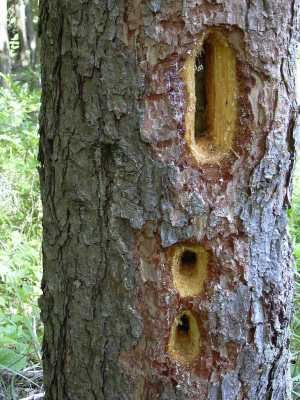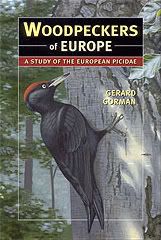 Several things differentiate the holes that woodpeckers create by foraging from those made for use as nesting cavities. Feeding holes do not lead to deep chambers, they almost always show pecks marks around the entrance, the hole will be irregular in shape and wood-chips are invariably piled up below the site outside the breeding season. Feeding holes are frequently at low levels on trees whereas nest-holes are usually high up. Fedding holes are often made in heavily rotting wood whereas neting holes are generally not. Holes made by Black Woodpecker to get at timber-dwelling carpenter ant colonies are often long oval, sometimes almost square, slits. Such holes can be up to 50cm long and 20cm wide. The photo of a typical, fresh, feeding site of Black Woodpecker in a pine with heart rot was taken in the Bukk Hills in northern Hungary (Szabolcs Kókay).
Several things differentiate the holes that woodpeckers create by foraging from those made for use as nesting cavities. Feeding holes do not lead to deep chambers, they almost always show pecks marks around the entrance, the hole will be irregular in shape and wood-chips are invariably piled up below the site outside the breeding season. Feeding holes are frequently at low levels on trees whereas nest-holes are usually high up. Fedding holes are often made in heavily rotting wood whereas neting holes are generally not. Holes made by Black Woodpecker to get at timber-dwelling carpenter ant colonies are often long oval, sometimes almost square, slits. Such holes can be up to 50cm long and 20cm wide. The photo of a typical, fresh, feeding site of Black Woodpecker in a pine with heart rot was taken in the Bukk Hills in northern Hungary (Szabolcs Kókay).Wednesday, 12 September 2007
Woodpecker signs: feeding holes
 Several things differentiate the holes that woodpeckers create by foraging from those made for use as nesting cavities. Feeding holes do not lead to deep chambers, they almost always show pecks marks around the entrance, the hole will be irregular in shape and wood-chips are invariably piled up below the site outside the breeding season. Feeding holes are frequently at low levels on trees whereas nest-holes are usually high up. Fedding holes are often made in heavily rotting wood whereas neting holes are generally not. Holes made by Black Woodpecker to get at timber-dwelling carpenter ant colonies are often long oval, sometimes almost square, slits. Such holes can be up to 50cm long and 20cm wide. The photo of a typical, fresh, feeding site of Black Woodpecker in a pine with heart rot was taken in the Bukk Hills in northern Hungary (Szabolcs Kókay).
Several things differentiate the holes that woodpeckers create by foraging from those made for use as nesting cavities. Feeding holes do not lead to deep chambers, they almost always show pecks marks around the entrance, the hole will be irregular in shape and wood-chips are invariably piled up below the site outside the breeding season. Feeding holes are frequently at low levels on trees whereas nest-holes are usually high up. Fedding holes are often made in heavily rotting wood whereas neting holes are generally not. Holes made by Black Woodpecker to get at timber-dwelling carpenter ant colonies are often long oval, sometimes almost square, slits. Such holes can be up to 50cm long and 20cm wide. The photo of a typical, fresh, feeding site of Black Woodpecker in a pine with heart rot was taken in the Bukk Hills in northern Hungary (Szabolcs Kókay).
Subscribe to:
Post Comments (Atom)





No comments:
Post a Comment